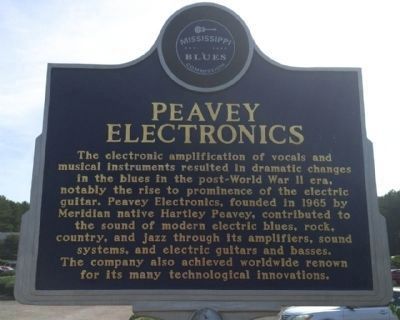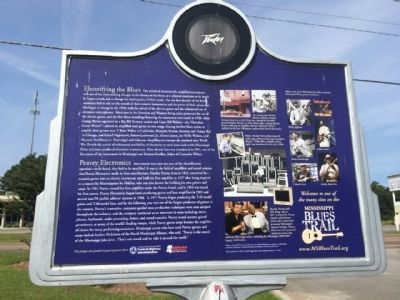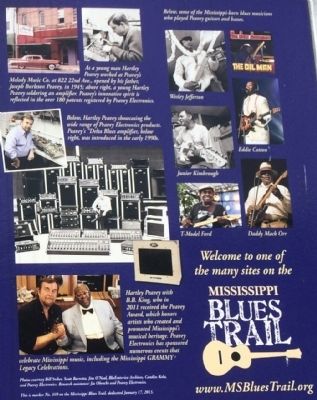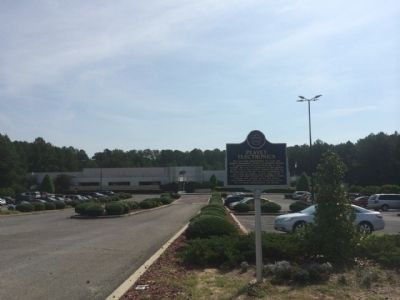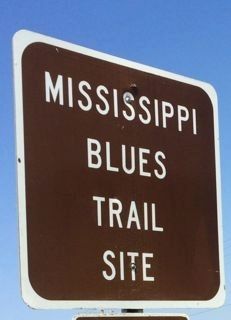Meridian in Lauderdale County, Mississippi — The American South (East South Central)
Peavey Electronics
Front
The electronic amplification of vocals and musical instruments resulted in dramatic changes in the blues in the post-World War II era, notably the rise to prominence of the electric guitar. Peavey Electronics, founded in 1965 by Meridian native Hartley Peavey, contributed to the sound of modern electric blues, rock, country, and jazz through its amplifiers, sound systems, and electric guitars and basses. The company also achieved worldwide renown for its many technological innovations.
Rear
Electrifying the Blues The arrival of electronically amplified instruments was one of the most striking changes in the history of the blues, as it allowed musicians to be heard by larger crowds and to change the aural quality of their music. For the first decades of the blues musicians had to rely on the sounds of their acoustic instruments and the power of their voices, but this began to change in the 1930s with the arrival of the electric guitar and the widespread use of electronic microphones. Musicians in the Hawaiian and Western Swing styles pioneered the use of the electric guitar, and the first blues recordings featuring the instrument were made in 1938, when George Barnes appeared on a Big Bill Broonzy session and Casey Bill Weldon—the “Hawaiian Guitar Wizard”—played an amplified steel guitar on two songs. Among the first blues artists to amplify their guitars were T-Bone Walker in California, Memphis Minnie, Broonzy, and Tampa Red in Chicago, and Robert Nighthawk, Robert Lockwood, Jr., Elmore James, Joe Willie Wilkins, and Houston Stackhouse in Mississippi and Arkansas. Amplification became the standard after World War II with the arrival of widespread availability of electricity to rural areas such as the Mississippi Delta and mass-produced electronic instruments. After electric bass was introduced in 1951, one of the first users of the instrument in Mississippi was Herman Fowlkes, father of Cassandra Wilson.
Peavey Electronics Instruments were just one part of the electrification equation—to be heard, they had to be amplified. It was in the field of amplifiers and sound systems that Peavey Electronics made its first contributions. Hartley Peavey, born in 1941, converted his acoustic guitar into an electric instrument and built his first amplifier in 1957 after being inspired at a concert by Mississippian Bo Diddley, who was also known for building his own guitars and amps. In 1961 Peavey created his first amplifier under the Peavey brand, and in 1964 was issued his first patent. Peavey Electronics began hand-producing guitar and bass amplifiers in 1965 and moved into PA (public address) systems in 1968. In 1977 Peavey began producing the T-60 model guitar and T-40 model bass, and by the following year was one of the largest producers of guitars in the country. Peavey’s innovative, computer-guided mass production techniques were soon adopted throughout the industry, and the company continued as an innovator in areas including microphones, keyboards, audio processing, drums, and sound consoles. Peavey sound systems gained prominence at many of the world's leading venues, while Peavey guitar amps became the amplifier of choice for many performing musicians. Mississippi artists who have used Peavey guitars and amps include Luther Dickinson of the North Mississippi Allstars, who said, “Peavey is the sound of the Mississippi juke joint. That's our sound and we take it around the world.”
Erected 2013 by the Mississippi Blues Commission. (Marker Number 169.)
Topics and series. This historical marker is listed in these topic lists: Arts, Letters, Music • Entertainment • Industry & Commerce. In addition, it is included in the Mississippi Blues Trail series list. A significant historical year for this entry is 1965.
Location. 32° 24.737′ N, 88° 41.985′ W. Marker is in Meridian, Mississippi, in Lauderdale County. Marker is on State Highway 493, 0.1 miles north of North Hills Street, on the right when traveling north. Touch for map. Marker is at or near this postal address: 5022 Hartley Peavey Drive, Meridian MS 39305, United States of America. Touch for directions.
Other nearby markers. At least 8 other markers are within 3 miles of this marker, measured as the crow flies. Site of Meridian Male College (approx. 1˝ miles away); Site of Meridian College and Conservatory (approx. 1.6 miles away); Gillespie V. "Sonny" Montgomery (approx. 1.8 miles away); Poplar Springs Road Historic District (approx. 2.2 miles away); 10th Avenue Masonic Cemeteries (approx. 2.4 miles away); St. John Baptist Church (approx. 2.4 miles away); St. Joseph Catholic Church (approx. 2.4 miles away); Lewis Edmund "Buck" Crook, Jr. (approx. 2.4 miles away). Touch for a list and map of all markers in Meridian.
Also see . . .
1. Company website. (Submitted on September 16, 2014, by Mark Hilton of Montgomery, Alabama.)
2. Mississippi Blues Trail website. (Submitted on September 16, 2014.)
Credits. This page was last revised on May 29, 2017. It was originally submitted on September 16, 2014, by Mark Hilton of Montgomery, Alabama. This page has been viewed 707 times since then and 30 times this year. Last updated on September 16, 2014, by Mark Hilton of Montgomery, Alabama. Photos: 1, 2, 3, 4, 5, 6. submitted on September 16, 2014, by Mark Hilton of Montgomery, Alabama. • Bill Pfingsten was the editor who published this page.
